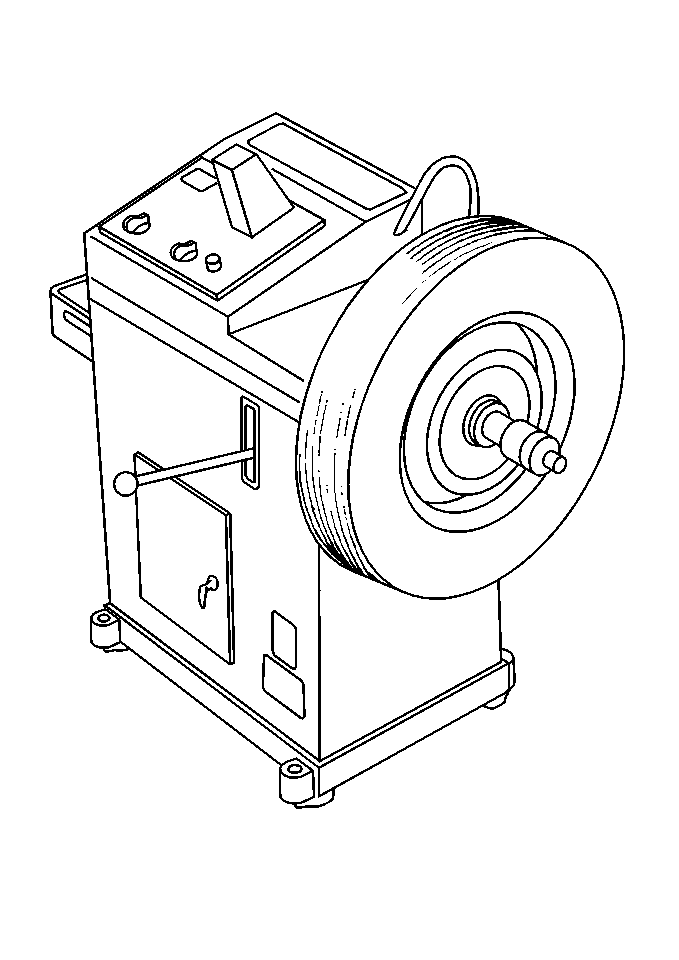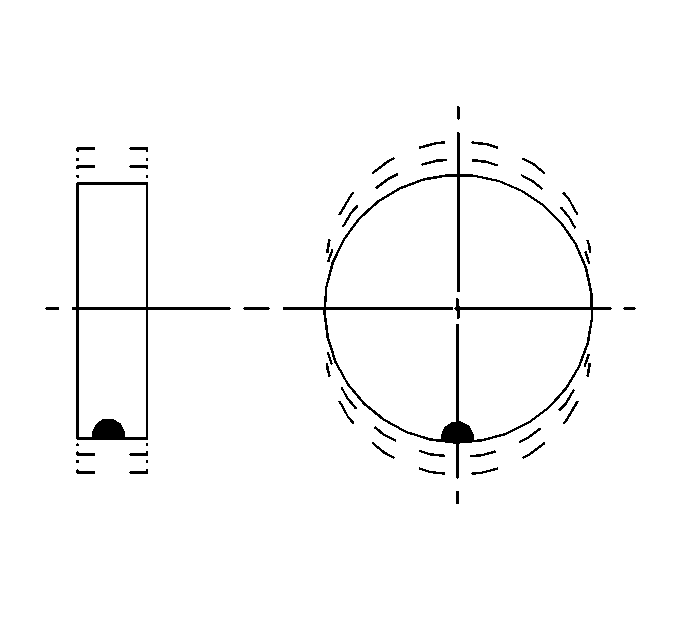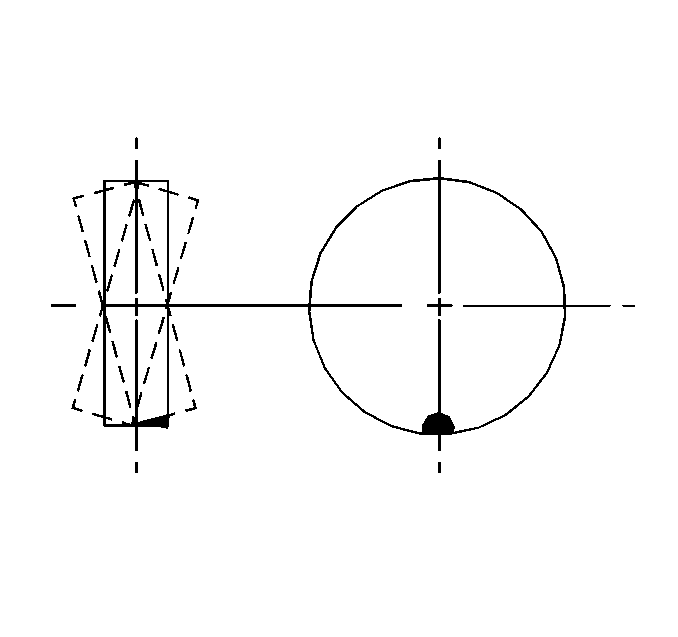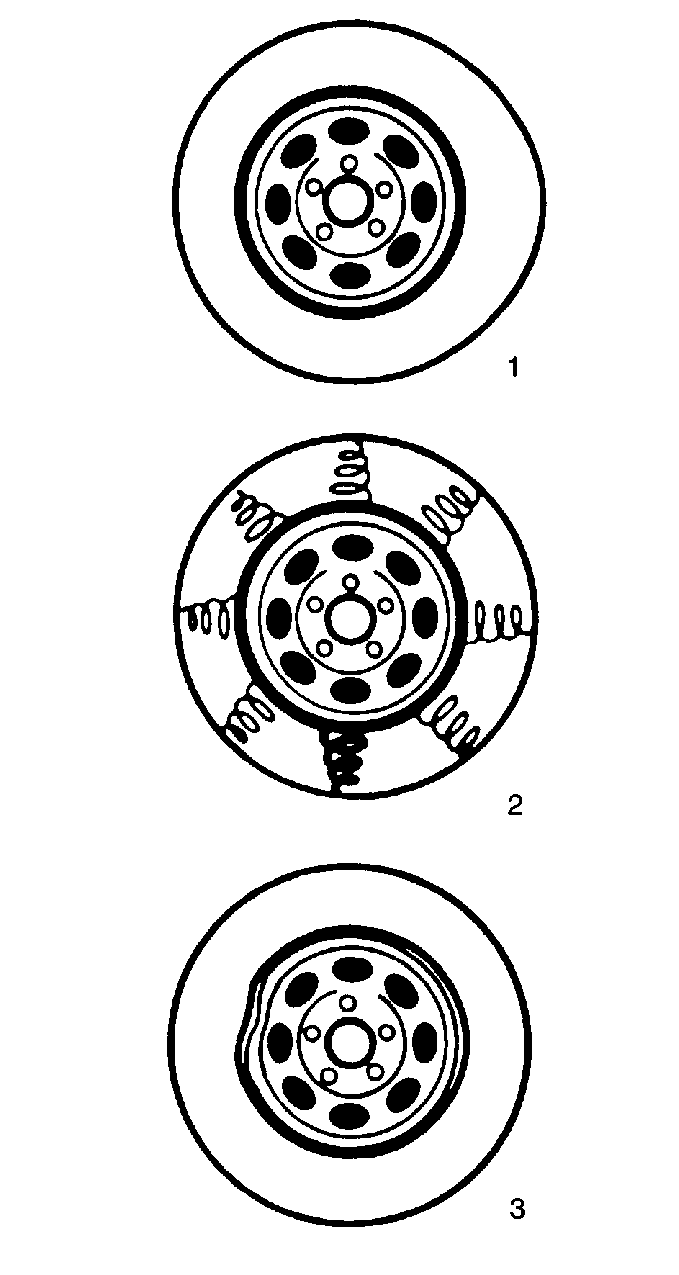Caution: Failure to adhere to the following precautions before tire balancing
can result in personal injury or damage to components:
| • | Clean away any dirt or deposits from the inside of the wheels. |
| • | Remove any stones from the tread. |
| • | Use coated weights on aluminum wheels. |
Important: The tires can be balanced either on-vehicle or off-vehicle, but the
off-vehicle balancing procedures are recommended. Off-vehicle methods are
better because tire rotation will not affect the balancing. The off-vehicle
balancers are also more accurate than the on-vehicle balancers. Off-vehicle
balancers can perform dynamic balancing as well as static balancing.

Tire and wheel balancers
can drift out of calibration without warning, or can become inaccurate as
a result of abuse. The balancer calibration should be inspected every two
weeks, and whenever the readings are questionable.
Tire Balancer Calibration Test
- Spin the balancer without a wheel or any of the adapters on the
shaft.
- Inspect the balancer readings.
Specification
0.00-0.25 oz
- Balance a tire and wheel that is within radial and lateral tolerances
to ZERO.
- Add a 3 ounce test weight to the wheel at any location.
- Spin the tire and wheel again, noting the readings.
| • | In the static and dynamic modes, the balancer should call for
3 ounces of weight, 180 degrees opposite the test weight. |
| • | In the dynamic mode only, the weight should be called for on the
flange of the wheel opposite the last weight. |
- With the tire and wheel unbalanced to 3 ounces, cycle the
balancer 5 times.
- Take the balancer readings:
Specification
Variation: 0.25 oz or less
- Index the tire and wheel at four separate locations on the balancer
shaft, 90 degrees apart.
- Cycle the balancer with the tire and wheel at each location.
- Take the balancer readings:
Specification
Variation: 0.25 oz or less
Tire Balancing Guidelines
Static and dynamic balance are two kinds of tire and wheel balance:
| • |

Static balance, also called
single plane balance, affects the distribution of weights around the wheel
circumference. |
| • |

Dynamic balance, or two-plane
balance, affects the distribution of weight on each side of the tire and wheel
centerline. |
Most off-vehicle balancers are capable of checking both types of balance
simultaneously.
As a general rule, most vehicles are more sensitive to static imbalance
than to dynamic imbalance, with as little as 0.50-0.75 oz capable
of inducing a vibration in some vehicles. Vibration induced by static imbalance
will cause a vertical or BOUNCING motion of the tire.
Dynamic imbalance results in a side-to-side motion of the tire. This
motion is referred to as SHIMMY.
| • | Balance all four tires as close to ZERO as possible. |
| • | Carefully follow the wheel balancer manufacturer's instructions
for proper mounting techniques to be used on different types of wheels. |
| • | Regard aftermarket wheels, especially those incorporating universal
lug patterns, as potential sources of runout and mounting problems. |
| • | Use the correct coated weights on aluminum wheels. |
| • | Recheck the tire and wheel for excessive runout after they have
been corrected and installed. |
| • | Evaluate the vehicle at the complaint speed and note if the vibration
has been corrected. |
| • | If the vibration is still present, or is reduced but still unacceptable,
you may find one of two possibilities: |
| - | Radial or lateral force variation |
Correcting On-Vehicle Imbalance
On-vehicle imbalance may result from components other than the tire
and wheel having imbalance. An on-vehicle high-speed balance or replacement
of suspected components may be necessary in order to correct the condition.
Rotors do not have a set tolerance. However, rotors with more than 0.75 ounce
imbalance have the potential to cause vibration. The rotors can be inspected
for imbalance using either the on-vehicle or the off-vehicle method as described
below:
Checking Rotor Imbalance (On-Vehicle)
- Raise and suitably support the vehicle. Refer to
Lifting and Jacking the Vehicle
in General Information.
- Remove the tires and wheels. Refer to
Wheel Removal
in Tires and Wheels.
- Reinstall the wheel nuts in order to retain the rotors.
Caution: One or more of the following guidelines may apply when performing specific required tests in the work stall:
| • | When a test requires spinning the drive wheels with the vehicle jacked up, adhere to the following precautions: |
| - | Do not exceed 56 km/h (35 mph) when spinning one drive wheel with the other drive wheel stopped. This limit is necessary because the speedometer indicates only one-half the actual vehicle speed under these conditions. Personal injury
may result from excessive wheel spinning. |
| - | If all of the drive wheels are spinning at the same speed, do not exceed 112 km/h (70 mph). Personal injury may result from excessive wheel spinning. |
| - | All persons should stay clear of the rotating components and the balance weight areas in order to avoid possible personal injury. |
| - | When running an engine in the repair stall for an extended period of time, use care not to overheat the engine and the transmission. |
| • | When a test requires jacking up the vehicle and running with the wheels and brake rotors removed, adhere to the following precautions: |
| - | Support the suspension at normal ride height. |
| - | Do not apply the brake with the brake rotors removed. |
| - | Do not place the transmission in PARK with the drive axles spinning. |
| - | Turn Off the ignition in order to stop the powertrain components from spinning. |
| • | When running an engine in the work stall, use the exhaust removal system to prevent breathing dangerous gases. |
- Take the necessary precautions.
- Run the powertrain (axles and rotors) at the complaint speed while
inspecting for vibration.
- Release the accelerator and slowly apply the brakes until the
powertrain comes to a complete stop. Turn the engine OFF.
- If the vibration still exists, perform the following steps:
| 7.2. | Run the powertrain (axle) at the complaint speed while inspecting
for vibration. |
| 7.3. | Release the accelerator and turn the engine OFF. |
- If the vibration is eliminated, perform the following steps:
| 8.2. | Perform the vibration test for each rotor. |
| 8.3. | Replace the rotor causing the imbalance. |
| 8.4. | Verify that the new rotor does not exhibit an imbalance. |
Checking Rotor and Drum Imbalance (Off-Vehicle)
- Measure the diameter and the width of the rotor or drum.
- Mount the rotor or drum on a balancer in the same manner as a
wheel.
Important: Rotors and drums can only be inspected for static imbalance. Ignore
the dynamic imbalance reading.
- Inspect for static imbalance.
On-Vehicle Balancing Procedure
The vibration problem may not be correctable with the components removed
from the vehicle. An on-vehicle high-speed balancer may be required in order
to balance the tires and wheels while still mounted on the vehicle. On-vehicle
balancing will balance the hubs and the rotors simultaneously, and will
compensate for any residual runout encountered as a result of mounting the
tires and wheels on the vehicle as opposed to off-vehicle balancing.
Follow the on-vehicle balancer manufacturer operator's manual for specific
instructions while keeping the following tips in mind:
Balancing Tips
| • | Do not remove the off-vehicle balancing weights. The purpose of
on-vehicle balance is to FINE TUNE the tire and wheel balance already achieved,
not to start over again. |
| • | If the on-vehicle balance calls for more than 1 ounce of
additional weight, split the weight between the inboard and outboard flanges
of the wheel, so as not to upset the dynamic balance of the tire and wheel
that was achieved in the off-vehicle balance. |
| • | An EVA vibration sensor placed on the fender of the vehicle during
the on-vehicle balance is an excellent indicator of the amplitude of the vibration,
and the effect that the balance has on the vibration. |
| • | Evaluate the vibration after the on-vehicle balance in order to
determine if the vibration condition has been resolved. |
Radial Force Variation





